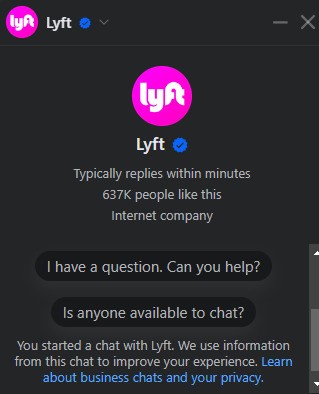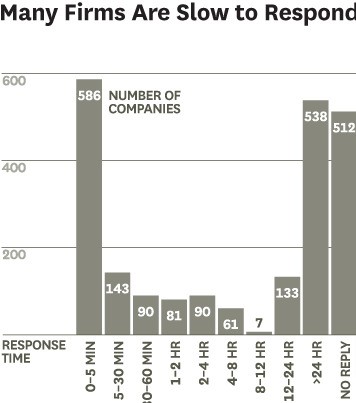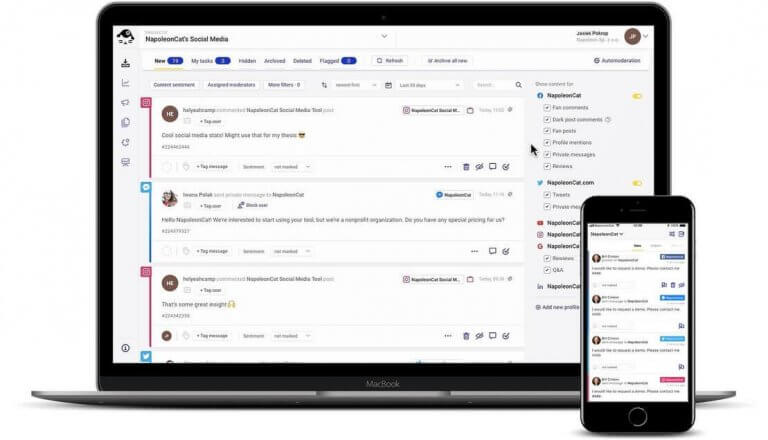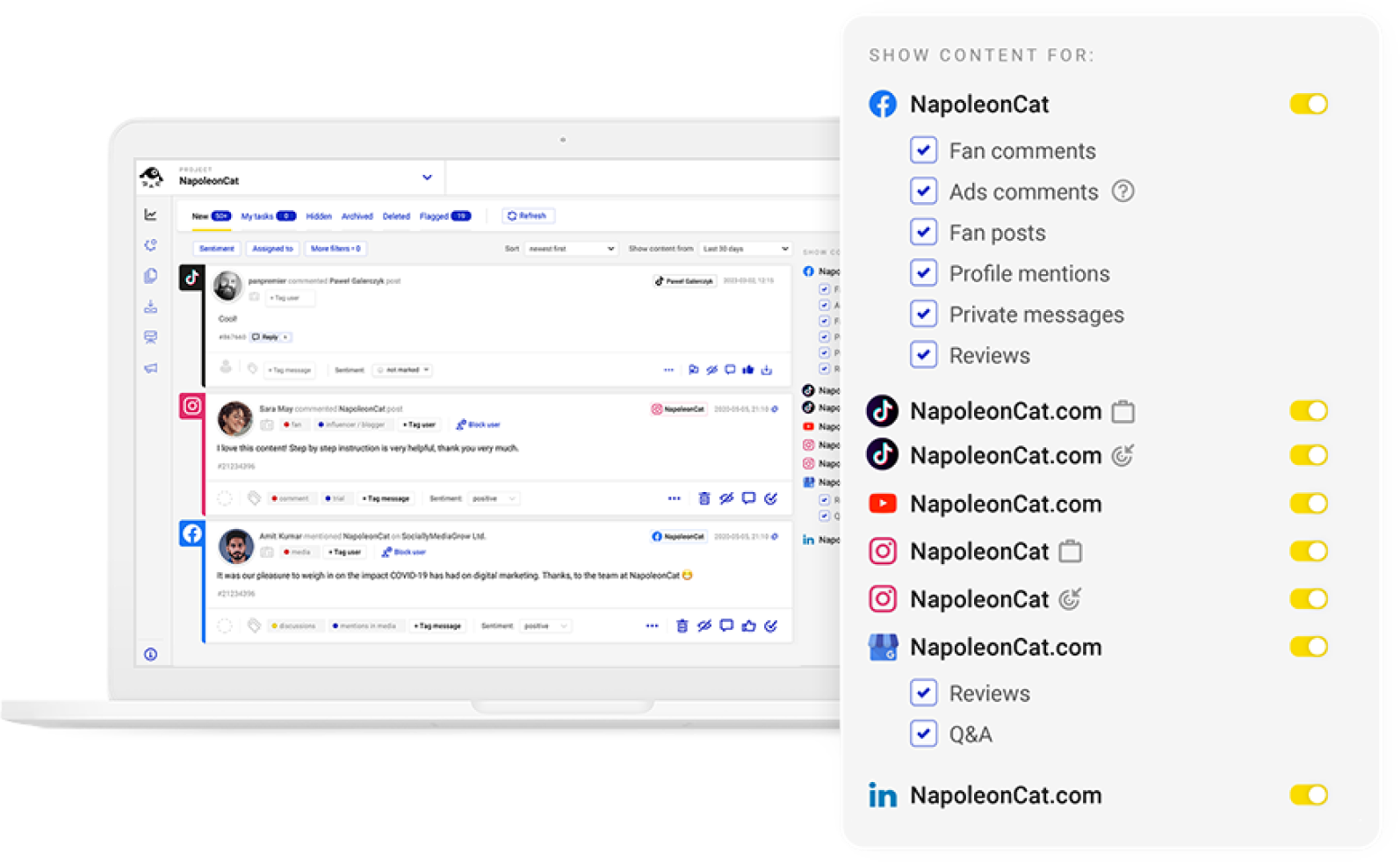Marketers get so caught up in trying to grab their audience’s attention that they often commit a critical mistake: treating marketing like a one-sided affair.
You want your prospects to care about your brand and offerings? Communicate with them in ways that feel like a real conversation.
And when I say “real conversation,” I mean immediate, relevant, and engaging interactions that make them feel heard and valued.
But how do you do that in an era where too many channels and touchpoints are competing for your audience’s attention?
Conversational marketing can help you.

Social media moderation tool for teams
Moderate all comments and messages from one dashboard, individually or in a team – with an all-in-one social media tool (Instagram DMs and ads included!)
What’s conversational marketing?
Conversational marketing is an approach that engages prospects and customers in a two-way dialogue across multiple channels in real time. It enables brands to keep the conversation going, gain customer insights, and provide customers with personalized experiences that drive sales.
To employ conversational marketing in your business typically means using automation tools like chatbots, live messaging, automated email, and social media automation.
That doesn’t mean human-to-human interaction isn’t involved. In fact, the goal of using automation is to enable marketers and salespeople to serve prospects and customers better.
Perhaps the best way to illustrate how conversational marketing works is through chatbots. It goes something like this: you visit a website or social media page, and then a chat window pops up, offering assistance or asking if you need help. And so on.

I don’t know about you, but it sure beats filling out a long web form or searching for a “Contact Us” page to write an email – and then waiting for an entire day (or two days) for a response.
With conversational marketing, you get a reliable system to keep prospects engaged enough to continue the conversation. Through that two-way dialogue, you can gather more insights about your customers and tailor your responses to meet their needs — you know, the same old formula for driving high engagement and boosting sales.
Why is conversational marketing important?
Let’s explore why conversational marketing is a critical component of your marketing strategy and, for that matter, your social media marketing strategy.
It keeps the conversation going
When a prospect visits your website or social media page, you can engage them immediately with a friendly greeting and personalized assistance.
If they show initial interest and you greet them with radio silence, the odds of that prospect wanting to do business with you drop significantly.
In fact, a Harvard Business Review study shows that brands have to respond within five minutes to have the best chance of turning a prospect into a qualified lead. Go beyond that five-minute window and your chances of qualifying that lead drop by 400%.

To convert interest into sales, you need to keep the conversation going. This is where conversational marketing excels. By engaging prospects in a two-way dialogue that prioritizes their needs and pain points, you can maintain their attention long enough to make them seriously consider buying.
This approach gives them a reason to care about what you’re saying. Most importantly, it shows that you acknowledge their problems and understand how they can benefit from your offerings.
In marketing terms, this is known as guiding them down your sales funnel.
Enables personalized customer experiences
Let’s face it: when customers contact your brand, their ultimate goal is to look out for themselves. To keep them interested, you must provide them with personalized customer experiences. After all, 82% of customers will tell you that personalization influences their brand choice.
To deliver personalized experiences, you must understand your prospects’ individual needs, preferences, and behaviors and tailor your interactions and offerings to meet those specific requirements.
That way, they’ll know that you’re looking out for their best interests. And they’ll reward you for it.
But personalization can be challenging. In fact, only 24% of businesses rate their personalization efforts as highly effective.
Conversational marketing makes personalization easier because it provides opportunities to engage prospects in a conversation that’s contextually relevant to their interests. That way, you get them to open up. And when prospects open up, you can gather the customer insights you need to deliver even more relevant experiences and offers.
It helps you close deals faster
The fastest way to lose a potential sale is to bulldoze prospects into buying. Even engaged prospects may still have questions they need answered before making that final decision.
Push too hard and they might think they smell a rat. Before you know it, they’re making all kinds of excuses so they won’t get “pressured” into making a purchase.
The better way is to maintain a two-way dialogue that addresses their concerns, builds trust, and provides clear, detailed information, ultimately helping you close deals faster.
According to a study, 67% of customers are more likely to purchase from a company that lets them get answers over messaging.
Conversational marketing also enables you to qualify prospects earlier. By asking the right questions, you can gather the relevant customer information you need to qualify your leads. This way, you get established criteria to help you prioritize the right prospects, which in turn, helps you close deals faster.
Improves customer service
If you think customer service is irrelevant in the age of machine learning and AI, you have another thing coming. In an era where customers can interact with brands via multiple channels, customer service is still essential to customer experience.
97% of consumers will tell you that customer service is crucial for winning their loyalty. What’s more, 78% of customers would give a brand a second chance after a mistake if their customer service is excellent.
Conversational marketing can improve customer service in many ways. For one, customers don’t have to wait hours or days to receive an answer to their questions. Since you can ask the right questions and get the answers instantly, you get the customer insights you need to deliver personalized experiences.
What’s more, your customer service or sales staff can leverage these insights to provide tailored advice and solutions that truly meet customer needs, enhancing their ability to act as consultants rather than just salespeople.

The best social media moderation tool
Manage all your comments, messages, and more – with an all-in-one social media tool. Facebook, Instagram, TikTok, LinkedIn, YouTube, Messenger, Google My Business, Google Play Store, and Apple App Store are supported.
How does conversational marketing work?
By this point, you already have a good idea of how conversational marketing works. But how does that look in practice?
Drift, the company that coined the term, recommends the Conversational Framework, which consists of three steps: Engage, Understand, and Recommend.
The 3-step Conversational Framework would be:
- Engage
- Understand
- Recommend
1. Engage
When a prospect or customer makes the first move – whether through your website, social media, or app – a chatbot or live messaging system can greet them, answer common questions, and guide them toward relevant resources or representatives.
The idea here is to engage them in a two-way conversation in real time. Make sure each response is contextually relevant, creating a real-time interaction that feels personalized and helpful.
As mentioned earlier, you can use chatbots on your website or social media accounts/pages to engage prospects in relevant and personalized ways. You can also use email automation to continue the conversation beyond the initial interaction.
NapoleonCat’s Social Inbox enables you to create this type of engagement on social media. With this social engagement tool, you can view all your social media conversations in one convenient dashboard, allowing you to manage and respond promptly to comments, messages, and mentions — and this works for Facebook, Instagram, TikTok, LinkedIn, Google My Business, and YouTube.

And if you’re getting more comments and messages than you (or your team) can handle, NapoleonCat’s Auto-moderation feature allows you to set up automatic replies to frequently asked questions (e.g., sizing, delivery times, hours of operation, ways of reaching your customer service team, etc.), cutting down the time spent replying by as much as 66%.
We highly recommend you test NapoleonCat completely for free – no credit card required 😉
With that amount of time saved, you can focus on:
- Understanding your customers
- Empathizing with their concerns
- Making recommendations that address their needs
See what I did there? That covers the remaining steps in our 3-step conversational framework!
2. Understand
To understand what makes your prospects and customers tick, you need to ask the right questions. Think of questions as tools that help you foster openness and create a dialogue that explores, shapes, and defines your audience’s needs.
But don’t ask so many questions that your prospects feel like they’re being interrogated. You also need to listen actively and analyze their responses. Pay close attention to the details, read between the lines, and understand the context of their concerns. Do that, and you will gain valuable insights into what they truly need and want.
This part can get a bit tricky when you’re using AI-driven tools. Unlike humans, AI isn’t capable of empathy. There will be times when a chatbot needs to hand over to a human agent to ensure that complex or sensitive issues are handled with the necessary care and understanding.
To write chatbot scripts and automated email sequences effectively, you need to strike a balance between automated responses and the human touch.
As a social media engagement tool, NapoleonCat not only helps you add a more human touch to your conversational marketing but also puts you in an ideal position to provide excellent social media customer service.
By funneling all customer queries and messages into one place, you and your team can respond quickly and effectively. And because the tool helps them save time, they can engage your prospects in ways that make them feel valued and appreciated.

Social media moderation tool for teams
Moderate all comments and messages from one dashboard, individually or in a team – with an all-in-one social media tool (Instagram DMs and ads included!)
3. Recommend
If you want to build trust, strengthen relationships, and increase the likelihood of converting a prospect into a loyal customer, give them honest and helpful recommendations, not sales pitches.
If a lead ends up not being the right fit, so what? They will appreciate your honesty and may still refer others to your business, knowing they can trust your integrity and value. If a prospect becomes a customer but turns out they’re a bad fit, they might become frustrated and harm your reputation. Hardly worth it, if you ask me.
Use the customer data you’ve gathered about each buyer to tailor your recommendations. Use the tools at your disposal to facilitate real-time conversations. And if the prospect needs to speak with a sales rep, make sure they are connected quickly to someone who can provide personalized, relevant, and empathetic advice.
Using NapoleonCat, every customer interaction becomes a customer service ticket, which you can assign to a team member. And since all social media comments, questions, or complaints can be tracked and managed under one dashboard, you can rest easy every customer issue is addressed to the best of your customer support team’s ability, and with utmost empathy.
Conversational Marketing Examples
1. Katie Barber Marketing
Katie Barber Marketing is a digital marketing agency that leverages conversational marketing to help its clients build a thriving brand community. To say that the agency overdelivers is an understatement. In fact, Katie Barber and her team grew a client’s TikTok account from 0 to 6.5k followers in just 4 months.

They did it by making full use of NapoleonCat’s capabilities. With Social Inbox helping them keep track of all customer comments, messages, and conversations in real-time and without delay, they made sure every interaction was addressed promptly and effectively.
The result? An engaged community that keeps growing at unbelievable rates. This positioned Katie Barber Marketing as a trusted partner in digital marketing and social media management.
2. ASKO – NÁBYTEK
ASKO—NÁBYTEK, a leading furniture retailer in Central Europe, integrated conversational marketing by using chatbots on its e-commerce platform.
The chatbots handled over 1,700 customer interactions monthly, resolving 50% of queries without human intervention. This not only reduced response times but also fueled their customer support.
The chatbots also helped them generate leads effectively, enabling them to acquire approximately 600 new email contacts monthly. Thanks to the valuable insights they gathered from these tools, they were able to personalize their marketing campaigns.
3. Vendavo
Vendavo leveraged conversational marketing effectively through automated emails using 6sense Conversational Email, a tool that facilitates real-time, personalized interactions with prospects.
This enabled Vendavo to engage thousands of contacts efficiently. Every follow-up they made was timely, increasing their average meeting booking by 10%.
Vendavo also used AI-powered assistants like ‘Lisa’ to automate email outreach. This resulted in 66 qualified contacts, 19 meetings booked, and 10 opportunities amounting to $3.3M in 2022 alone.
Wrap up
Marketing is about building trust. To earn that trust among your audience, you have to engage them in ways that prioritize their needs and interests.
It’s not going to be easy. But by adopting a conversational marketing strategy, you’re in a better position to deliver customer experiences that are engaging and personalized, ultimately building the trust necessary to drive sustainable growth for your business.

Social media moderation tool for teams
Moderate all comments and messages from one dashboard, individually or in a team – with an all-in-one social media tool (Instagram DMs and ads included!)
You may also like:
- How to Provide Excellent Social Media Customer Service
- Top 10 Customer Service Tools
- What is a Social Media Moderator (and how to become one)?
- Support Your Team With a Social Media Moderation Tool They Deserve
- The Best Facebook Moderation Tool for eCommerce
- A Guide to More Efficient Content Moderation for Businesses
- Why You Should Automate Facebook Ad Comment Moderation
- How to Build a Social Media Community
- How to Monitor Social Media for Negative Reviews and Protect Your Brand Reputation
- The Best Social Media Crisis Management Tool





